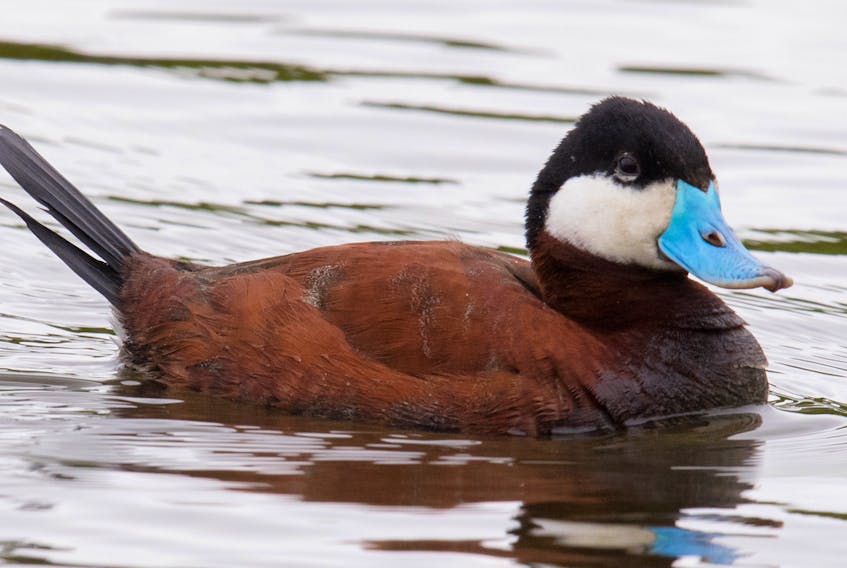The Quidi Vidi Lake walkers are an observant group.
They may appear to be walking with the single- minded purpose of circumnavigating the lake for exercise but they do have an eye out to their surroundings. When something different appears along their route they notice it.
Ducks are expected at the west end of the lake. At this time of year, some are loafing on the beach while others are dabbling in the water. The families of cute little ducklings are a universal attention grabber. But on June 6, a stranger came to town.

It was a tiny little duck with a truck load of distinction. It had a candy blue bill, a bold white cheek patch, a black cap and a deep rich mahogany-red body with a long stiff tail that stuck straight up in the air. It was hard not to notice it. Birders certainly did.
It was Alex McInnis who was first among the birding group to see it and spread the news early on the morning of June 6. Everyone came to see this exquisite rarity.
Ruddy duck is a western species. It is most at home on the ponds of the Prairie Provinces. Small numbers nest as far east as Ontario.
Newfoundland gets the occasional stray ruddy duck in the fall. In fall plumage, they are dull brown ducks lacking the gaudy outfit that the males sport in spring and summer. Back in April 2014, there was another spring ruddy duck at Quidi Vidi Lake. This ruddy duck was not going to go unnoticed among the regular crowd of town ducks and domestic fare.
It is here now and could stay for the whole summer. Typical among ducks, the males leave the females after she starts incubating the eggs in the nest. By the time the eggs hatch, the male is long gone. The dull more protective colouration of female aids in her ability to avoid attention from predators as she takes care of her brood of ducklings. The gaudy coloured male ducks go elsewhere for the summer to moult their feathers. They find a place where they can be safe from predators for they will be flightless for a few weeks during the moulting process. It is quite possible that the ruddy duck has chosen Quidi Vidi Lake as its place of refuge for the summer moulting process. During this time it will gradually lose its colourful attractiveness and become a dull brown ruddy duck. Meanwhile we can enjoy the duck in all its outrageous extravagance now.
Staycationing Birders
The COVID-19 pandemic obliterated vacationing plans for many people including birders this spring. As a backup plan to salvage some kind of birding holiday, the Newfoundland birders look to the Codroy Valley. Traditionally birders have gone to the Codroy Valley in the southwest corner of the island of Newfoundland for holiday birding in late spring and early summer. The lush soil and rich forest is different from anywhere else in the province.
In some ways the Codroy Valley is more similar to Nova Scotia than typical Newfoundland. There was an unusually good coverage of the Codroy Valley by birders from this spring. The results were fabulous. Codroy specialties such as bay-breasted warbler, blackburnian warbler, Cape May warbler and northern parula were located in record numbers. The normally quite rare eastern phoebe and eastern wood-pewee were found in multiples. Never heard before singing in Newfoundland scarlet tanagers were found at Loch Lomond and on Brooms Brook. A southern vagrant, the little blue heron found a refuge in a small cattail marsh in the community of Codroy.
The COVID-19 pandemic obliterated vacationing plans for many people including birders this spring. As a backup plan to salvage some kind of birding holiday, the Newfoundland birders look to the Codroy Valley. Traditionally birders have gone to the Codroy Valley in the southwest corner of the island of Newfoundland for holiday birding in late spring and early summer. The lush soil and rich forest is different from anywhere else in the province.
The grand prize of the Codroy Valley birding blitz was a northern rough-winged swallow at Loch Lomond Pond. Its occurrence in Newfoundland was of nearly mythical status. The first occurrence in Newfoundland was actually from the Codroy Valley by the legendary Dr. Les Tuck, who accidentally caught one in a net set out for snipe that he was studying sometime in the 1960s. The bird died in the net and the specimen was prepared and preserved in the Newfoundland Museum on Duckworth Street, St. John’s, at the time.
I had the privilege of holding the specimen in my hand. I examined it with a kind of envy. I dreamed that someday I would see this brown swallow in all its drabness. It is easy to overlook among the other swallows zooming through the air pursuing insects. I am very pleased to say that it happened in the Codroy Valley this year. Alison Mews and I had excellent views of a northern rough-winged swallow feeding among a swallow flock over at Loch Lomond Pond on 13 June. We got the photographs to prove it. It just shows there is always reason to hope no matter how far away the end seems.
Bruce Mactavish is an environmental consultant and avid birdwatcher. He can be reached at [email protected]









